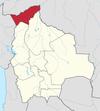The Rainiest Place in Bolivia: Bolivia for Kids
by Kricket
(BoliviaBella.com)

Today we'll learn about a small department (state) within Bolivia called Pando, and its capital city, Cobija.
Pando
The department of Pando is the northernmost state in Bolivia. It is 24,644 square miles in size, near the border to Brazil. Pando's population is 110,436 as of 2012. Pando is found at 280 meters above sea level and is the rainiest place in Bolivia. Though it is rainy, its climate is hot and the temperature is usually about 80° Fahrenheit. Photo Source.
Pando is rich in resources the main ones being gold, agriculture (Brazil nuts, corn, coffee, yucca, rice, tropical fruits and vegetables), timber, cattle ranching and fishing. It is mostly flat. It's name "pando" means "flat" in Spanish. Map Source.
Pando is one of Bolivia's 9 states, small in size. It used to be larger, but a part of its territory was annexed by Brazil after a war with Bolivia that lasted between 1899-1903. By the end of the 18th century, the Portuguese that lived nearby attacked this area of Bolivia (which used to be called Acre) because it was rich in rubber trees and gold. Brazil won the war, settled the area and claimed it as theirs.
Cobija
Cobija is the capital of the department of Pando and is 373 miles north of the city of La Paz, on the border of Brazil near the Amazon Basin. It is across the banks of the Acre River, across from Brasiléia, a town in Brazil. Cobija means "blanket".
Here's a drone video of the city of Cobija.
In 1906 its name was Bahía. Colonel Enrique Cornejo gave it its current name in 1908, in commeration to the old Bolivian seaport of Cobija which was lost to Chile during the Pacific War. The city of Cobija has a population of 56,000.
So now you know a bit more about the department of Pando and its capital city, Cobija. Who founded the state you live in? Answer in the comments below.
Pando
The department of Pando is the northernmost state in Bolivia. It is 24,644 square miles in size, near the border to Brazil. Pando's population is 110,436 as of 2012. Pando is found at 280 meters above sea level and is the rainiest place in Bolivia. Though it is rainy, its climate is hot and the temperature is usually about 80° Fahrenheit. Photo Source.
Pando is rich in resources the main ones being gold, agriculture (Brazil nuts, corn, coffee, yucca, rice, tropical fruits and vegetables), timber, cattle ranching and fishing. It is mostly flat. It's name "pando" means "flat" in Spanish. Map Source.
Pando is one of Bolivia's 9 states, small in size. It used to be larger, but a part of its territory was annexed by Brazil after a war with Bolivia that lasted between 1899-1903. By the end of the 18th century, the Portuguese that lived nearby attacked this area of Bolivia (which used to be called Acre) because it was rich in rubber trees and gold. Brazil won the war, settled the area and claimed it as theirs.
Cobija
Cobija is the capital of the department of Pando and is 373 miles north of the city of La Paz, on the border of Brazil near the Amazon Basin. It is across the banks of the Acre River, across from Brasiléia, a town in Brazil. Cobija means "blanket".
Here's a drone video of the city of Cobija.
In 1906 its name was Bahía. Colonel Enrique Cornejo gave it its current name in 1908, in commeration to the old Bolivian seaport of Cobija which was lost to Chile during the Pacific War. The city of Cobija has a population of 56,000.
So now you know a bit more about the department of Pando and its capital city, Cobija. Who founded the state you live in? Answer in the comments below.
Video source: https://youtu.be/nkJgwRS-aBg
Submitted 2015-04-03



